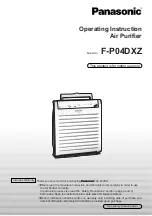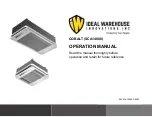
5
Unit Placement
Outdoor Unit Positioning Considerations
In addition to clearances, the following items should
be considered when setting the outdoor unit:
• Some local governments have adopted sound
ordinances based on the unit’s sound level reg-
istered from the adjacent property, not from the
property where the unit is installed. Install the
unit as far as possible from the property line.
• Glass has a very high level of sound transmis-
sion. When possible, do not install the unit direct-
ly outside a window.
• Avoid installing the unit in areas exposed to ex-
treme voltage variations (such as factories).
• Install unit level.
• Install the unit high enough above the ground or
roof to allow adequate drainage of defrost wa-
ter and prevent ice or snow build-up (required for
heat pumps).
• The unit base should be elevated above the
depth of average snows. In heavy snow areas,
do not locate the unit where drifting will occur.
• When installed in areas where low ambient tem-
peratures exist, locate unit so winter prevailing
winds do not blow directly into outdoor unit.
• Locate unit away from overhanging roof lines
which would allow water or ice to drop on, or in
front of, coil or into unit.
• Allow
suf
fi
cient space around unit for proper op-
eration and maintenance.
• Install the outdoor unit a minimum of 3 feet away
from any antenna, power cord (line), radio, tele-
phone, security system, or intercom. Electrical
interference and radio frequencies from any of
these sources may affect operation.
Lifting the Unit
• Do not hold the air inlet grille while lifting the unit.
This could result in damage to the cabinet.
• Do not touch the fan blades with your hands or
other objects while lifting the unit.
Installation
SLAB OR ROOF MOUNTING
Install the unit a minimum of 4 inches (102 mm)
above the roof or ground surface to avoid ice build-up
around the unit. Locate the unit above a load bearing
wall or area of the roof that can adequately support
the unit. Consult local codes for rooftop applications.
• Use
a
fi
eld-provided slab or frame as speci
fi
ed in
the Product Speci
fi
cations (EHB) bulletin.
• Install the unit in an upright and level position.
• If the unit coil cannot be installed away from
prevailing winter winds, a wind barrier should
be constructed. Size barrier at least the same
height and width as outdoor unit. Install barrier
12 inches (305 mm) minimum from the sides of
the unit in the direction of prevailing winds.
WARNING
Use the provided and specifi ed components when
installing equipment. Failure to do so may result in
unit falling, water leaking or electrical shocks, caus-
ing personal injury or equipment or property dam-
age.
Check stability of unit support. If sup
port is not
capable of carrying weight of the unit, unit may fall
causing personal injury or equipment damage.
Safely dispose of packing materials, which include
nails, wood and other sharp objects, as well as
plastic wrapping. Children playing with plastic wrap
or bags risk the danger of suffocation.
IMPORTANT
Exhaust vents from dryers, water heaters and
furnaces should be directed away from the
outdoor unit. Prolonged exposure to exhaust
gases and the chemicals contained within them
may cause condensation to form on the steel
cabinet and other metal components of the out-
door unit. This will diminish unit performance
and longevity.
IMPORTANT
Roof Damage!
This system contains both refrigerant and
oil. Some rubber roofi ng material may absorb
oil. This will cause the rubber to swell when
it comes into contact with oil. The rubber will
then bubble and could cause leaks. Protect the
roof surface to avoid exposure to refrigerant
and oil during service and installation.
Failure to follow this notice could result in dam-
age to roof surface.






































